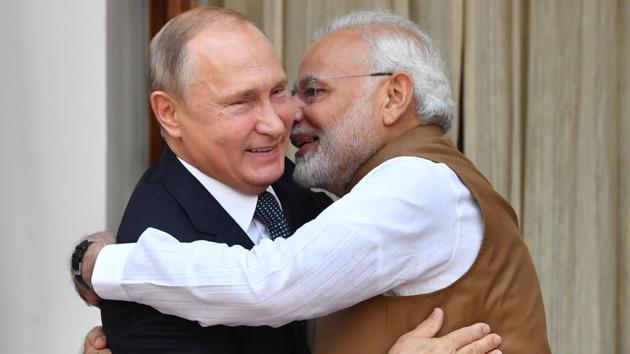Washington needs to appreciate India’s domestic political dynamic
A number of experts have questioned India’s wisdom in going forward with the S-400 deal despite knowing the risks to the India-US relationship. Some have also questioned the need for India investing so much into the Russia relationship even as the strategic worldview of New Delhi and Moscow have, of late, diverged considerably.
It is not often that one particular bilateral summit helps put a number of pieces in a country’s foreign policy jigsaw in place. The just concluded 19th India-Russia annual summit did just that. After this summit, one can see various strands of India’s engagements with major powers — the US, China and Russia itself. The S-400 deal was the main headline grabber. India chose to purchase the long range surface-to-air missile system from Russia risking US sanctions under its “Countering America’s Adversaries Through Sanctions Act” (CAATSA). Whether India eventually gets a waiver depends on the US President Donald Trump.

A number of experts have questioned India’s wisdom in going forward with the S-400 deal despite knowing the risks to the India-US relationship. Some have also questioned the need for India investing so much in the Russia relationship even as the strategic worldview of New Delhi and Moscow have, of late, diverged considerably. With these questions in the backdrop, three points need to be made.
First, India now seems to be realising that the real balancing it needs to do is between the US and Russia, and not between the US and China. Given the current warmth between Beijing and Moscow, the distinction may not be immediately obvious. But consider this: through its actions, China has made it clear to India that New Delhi and Beijing cannot become friends in the foreseeable future. India will have to resort to some kind of balancing with China. As TV Paul, James McGill Professor of International Relations with McGill University, has suggested, New Delhi’s approach may not go beyond soft balancing coalitions and limited hard balancing through acquisition of asymmetrical military capabilities. However, unlike in China’s case, India has not yet found half a coherent response which can manage its defence relationship with Russia in the face of Moscow’s growing unpopularity in the West.
Second, India’s continuous outreach to Russia also has to do with its quest for multipolarity in the global order. After his meeting with President Vladimir Putin, Prime Minister Narendra Modi said: “India and Russia are unanimous in strengthening multipolarity and multilateralism in this rapidly changing world.” Modi’s commendable efforts to strengthen ties with powers like Japan and France were also partly driven by this quest for multipolarity. However, it seems New Delhi has not thought through this multipolarity question in its entire depth. It is China’s rise that has given a big push to multipolarity. So while the goal of multipolarity may seem like an utopia, the path to it goes through China’s ascendance — a deeply discomforting proposition for India.
It is well known that China takes a dim view of India’s desire to get a high seat in institutions of global governance. India got a clean waiver from the full-scope safeguards condition of the Nuclear Suppliers Group (NSG) with the US help when the latter enjoyed pre-eminent status on the global stage. New Delhi’s effort to receive NSG membership hasn’t borne fruit in the post-financial crisis world where the US power has lost some of its shine.
Moreover, the multipolar end is not guaranteed either. We may end up with a bipolar world with spheres of influence divided between the US and China. Again, India would not want this eventuality because South Asia will then most definitely fall in China’s lap.
Third, while Modi has failed to sufficiently reimagine ties with Russia and hasn’t thought through the multipolarity quest, he has found the right pace to move the India-US relationship forward. Modi has been able to achieve a lot with the US: two foundational agreements—Logistics Exchange Memorandum of Agreement (Lemoa) and Communications Compatibility and Security Agreement (Comcasa)—that help the cause of interoperability between the two countries’ forces, the ‘major defence partner’ tag and Strategic Trade Authorisation-1 (STA-1) status for India that would shore up defence cooperation, and greater convergence among their respective Indo-Pacific strategies.
This has been possible because Modi is aware of potential tripwires. New Delhi’s desire to buy S-400 missile systems predates America’s CAATSA law. While Indian policymakers are not stupid enough to spend more than $5 billion just to exhibit their strategic autonomy—S-400 systems offer real value—it is true that India’s failure to go ahead with the deal would have strengthened voices in domestic politics that would have accused India of becoming a US lackey. Similarly, if India had last year voted in the United Nations in favour of Trump’s decision to recognise Jerusalem as Israel’s capital even as key US allies like Britain and France did not, Modi would have put India-US ties in the domestic political crossfire.
Washington needs to appreciate this aspect of India’s domestic political dynamic; the S-400 deal is not merely a result of the legacy of defence cooperation with Russia. A waiver from CAATSA is, therefore, eminently warranted but will likely come at a cost.
Kunal Singh is a New Delhi-based strategic affairs analyst
The views expressed are personal






